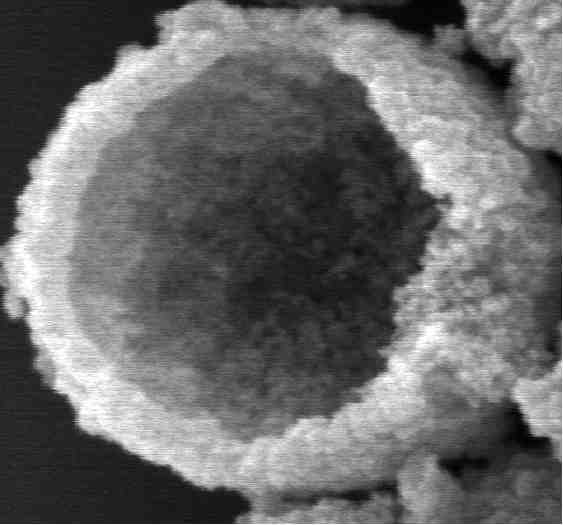
ACS PRF | ACS
All e-Annual Reports

44756-AC5
Functionalization and Application of Hollow Zeolite Structures
Zeolites present a unique opportunity for forming hollow structures with controlled porosity. Hollow zeolite structures are formed using mesoporous silica as a sacrificial template. The hollow zeolite structures consist of a shell that has the characteristic porosity and ion-exchange properties of the parent zeolite and interior and exterior surfaces that have terminal silanol groups which can be readily functionalized using organosilane reactions. We have developed strategies for functionalizing the interior and exterior surfaces of the hollow zeolite structures and the zeolite shell. The first strategy features functionalization of the mesoporous silica template with transition metals, such as copper and vanadium, or organosilanes, such as, aminopropyltriethoxysilane (APTES), in order to prepare hollow zeolite structures with encapsulated transition metals or organic functional groups. The second strategy involves post-synthetic modification of the zeolite hollow structures through transition metal ion-exchange of aluminosilicate hollow shell. The functionalized hollow zeolite structures are extensively characterized. The ability to encapsulate transition metal species on the interior of the hollow ZSM-5 tubes and to exchange transition metals into the shell of the zeolite is important for potential catalytic applications of these materials in particular for bifunctional catalysis involving reactions at different sites in the hollow zeolite capsule. The ability to functionalize with amine groups may prove to be important for adsorption of heavy metals for environmental remediation applications. Transition metals (copper and vanadium) were incorporated into hollow ZSM-5 tubes using an encapsulation process and in a post-synthesis ion-exchange. The encapsulated transition metal-containing ZSM-5 tubes have decreased surface areas relative to the parent and ion-exchanged ZSM-5 tubes, decreased amounts of incorporated transition metal relative to the post-synthesis ion-exchanged ZSM-5 tubes and an impurity phase as observed in the XRD patterns. The decreased amounts of transition metal for the encapsulation method is most likely related to the amount of transition metal incorporated into the mesoporous silica template. The decreased surface areas for the encapsulated transition metals suggest that these transition metals may be located in the ZSM-5 pore structure rather than exclusively on the internal surface. Insight into the local electronic environment of the Cu2+ and VO2+ in the ZSM-5 tubes was obtained from EPR spectroscopy. For the copper exchanged and encapsulated ZSM-5 tubes, the EPR spectra had similar spectral features indicating that copper is in a square planar (tetragonal) geometry with water or hydroxyl ligands in the plane. For the vanadium exchanged and encapsulated ZSM-5 tubes, the EPR spectra indicated that VO2+ is in octahedral coordination with water or hydroxyl groups as ligands. There are differences in the EPR parameters for the copper (and vanadium) encapsulated ZSM-5 tubes relative to the exchanged tubes, but the differences represent slight changes in the local electronic environment of the paramagnetic transition metal center rather than large changes in geometry or coordination environment which would be expected to cause more dramatic changes in the EPR spectra. Similar to the procedure for preparing transition metal encapsulated zeolite tubes, APTES was incorporated into silicalite hollow tubes. The MS template was functionalized with APTES using a well-known method for organic functionalization of MS materials. The surface area of the APTES functionalized silicalite tubes was 124 m2/g compared to approximately 240 m2/g for the unfunctionalized silicalite tubes, representing a significant decrease in surface area. This decrease in surface area has been observed previously for organic functionalized zeolites and is attributed to restricted access to the pores caused by the organic functional groups as is likely the case here. The functionalization of the MS template was monitored by 29Si MAS NMR and zeta potential measurements. For the APTES functionalized silicalite tubes, approximately 40% of the total silicon in the silicalite tubes is functionalized and the. The unfunctionalized silicalite tubes have a zeta potential of 14 mV at pH=7 and the APTES encapsulated silicalite tubes have a zeta potential of 38 mV at pH=6. The increase in the zeta potential to a larger positive number is consistent with the presence of positive amine groups on the surface of the APTES functionalized materials. Hollow zeolite structures were selectively functionalized with transition metals or an organosilane on the interior surface of the hollow structure and in the zeolite shell. The ability to encapsulate transition metal species on the interior of the hollow ZSM-5 tubes and to exchange transition metals into the shell of the zeolite is important in energy applications such as catalysis.
